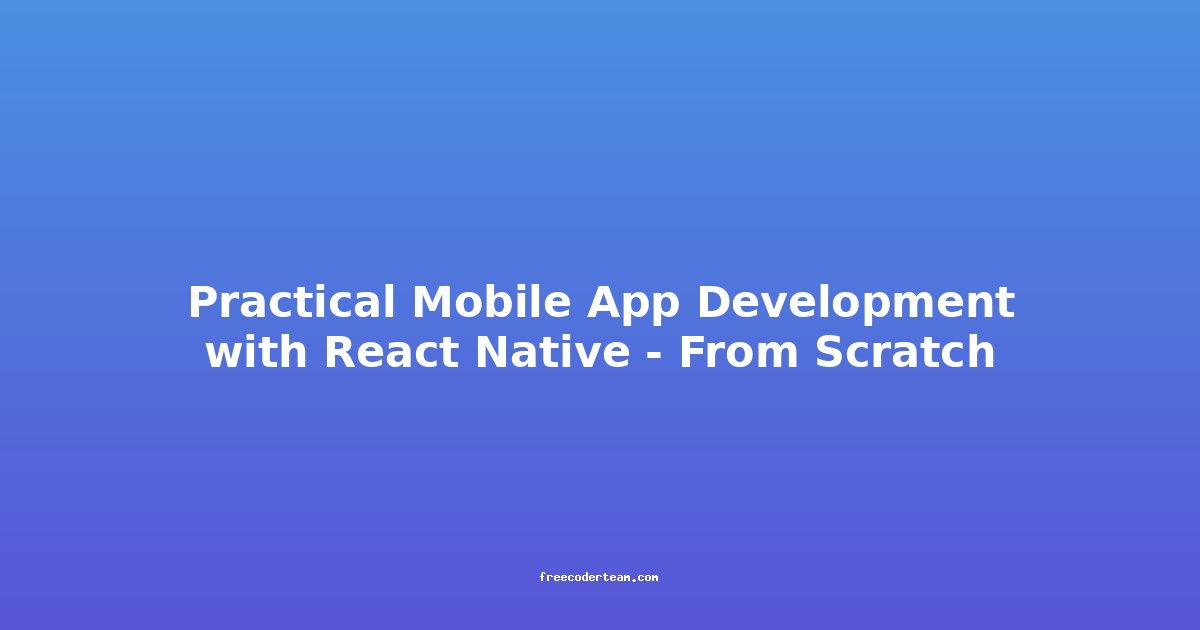Practical Mobile App Development with React Native: From Scratch
React Native is a powerful JavaScript framework that allows developers to build cross-platform mobile applications for iOS and Android. Unlike traditional native development, React Native enables you to write code once and deploy it across multiple platforms, saving time and resources. In this comprehensive guide, we'll walk through the process of building a mobile app using React Native, starting from the ground up. We'll cover setup, development best practices, and practical examples to help you get started.
Table of Contents
- Introduction to React Native
- Setting Up Your Development Environment
- Creating Your First React Native App
- Understanding the Basics of React Native
- Building a Simple To-Do App
- Best Practices for React Native Development
- Testing and Debugging
- Deploying Your App
- Conclusion
1. Introduction to React Native
React Native is based on Facebook's React library, which is widely used for building web applications. It uses the same principles of declarative UI and component-based architecture but is designed specifically for mobile development. React Native uses the same JavaScript code for both iOS and Android while leveraging native UI components, ensuring a smooth and performant user experience.
Key features of React Native include:
- Cross-Platform Development: Write code once and deploy it on both iOS and Android.
- Native Performance: Uses native UI components, ensuring a smooth and responsive experience.
- Large Community and Ecosystem: A robust library of tools, frameworks, and plugins.
- Hot Reloading: Instantly see changes in your app during development.
2. Setting Up Your Development Environment
Before you start building your app, you need to set up your development environment. Here's what you'll need:
Prerequisites
- Node.js and npm: React Native requires Node.js and npm (Node Package Manager) to manage dependencies. You can download them from Node.js official website.
- React Native CLI: This is the command-line interface used to create and manage React Native projects. Install it globally using:
npm install -g react-native-cli - Expo (Optional): Expo is a popular tool that simplifies React Native development by providing a web-based development environment. You can install it globally:
npm install -g expo-cli
Development Tools
- Code Editor: Use a modern code editor like Visual Studio Code, Sublime Text, or Atom.
- iOS Simulator (for macOS): If you're developing on a Mac, you'll need Xcode installed, which comes with the iOS Simulator.
- Android Studio (for Android): For Android development, you'll need Android Studio and the Android SDK.
Mobile Device (Optional)
While you can use simulators, testing on a physical device is highly recommended. Connect your device via USB and enable developer options to test your app in real-time.
3. Creating Your First React Native App
Let's create a new React Native project. We'll use the react-native-cli to set up our project.
Step 1: Initialize the Project
Open your terminal and run the following command to create a new React Native project:
npx react-native init MyAwesomeApp
This will generate a new folder named MyAwesomeApp with the necessary files and dependencies.
Step 2: Navigate to the Project Directory
cd MyAwesomeApp
Step 3: Run the App
To run the app, you need to specify the platform:
- iOS:
npx react-native run-ios - Android:
npx react-native run-android
If everything is set up correctly, you should see a default "Welcome to React Native!" screen in your simulator or device.
4. Understanding the Basics of React Native
React Native follows the same principles as React, including components, props, and state. Let's break down the key concepts:
Components
Components are the building blocks of React Native apps. They are reusable pieces of code that render UI elements.
Example: A Simple Component
import React from 'react';
import { View, Text, StyleSheet } from 'react-native';
const Header = () => {
return (
<View style={styles.header}>
<Text style={styles.title}>My Awesome App</Text>
</View>
);
};
const styles = StyleSheet.create({
header: {
backgroundColor: '#4287f5',
padding: 16,
},
title: {
color: 'white',
fontSize: 20,
fontWeight: 'bold',
},
});
export default Header;
Props
Props are used to pass data from a parent component to a child component.
Example: Using Props
import React from 'react';
import { View, Text, StyleSheet } from 'react-native';
const Greeting = ({ name }) => {
return (
<View style={styles.container}>
<Text style={styles.text}>Hello, {name}!</Text>
</View>
);
};
const styles = StyleSheet.create({
container: {
padding: 16,
},
text: {
fontSize: 18,
},
});
export default Greeting;
State
State is used to manage the internal data of a component. It's essential for handling user interactions.
Example: Managing State
import React, { useState } from 'react';
import { View, Text, TextInput, Button, StyleSheet } from 'react-native';
const Counter = () => {
const [count, setCount] = useState(0);
return (
<View style={styles.container}>
<Text style={styles.text}>Count: {count}</Text>
<Button title="Increment" onPress={() => setCount(count + 1)} />
</View>
);
};
const styles = StyleSheet.create({
container: {
padding: 16,
},
text: {
fontSize: 20,
marginBottom: 16,
},
});
export default Counter;
5. Building a Simple To-Do App
Let's build a simple To-Do app to demonstrate how React Native works in practice.
Step 1: Project Structure
Create the following files in your src directory:
App.js: The main entry point.components/TaskList.js: A component to display the list of tasks.components/AddTask.js: A component to add new tasks.
Step 2: Implement the App
App.js
import React, { useState } from 'react';
import { View, StyleSheet } from 'react-native';
import AddTask from './components/AddTask';
import TaskList from './components/TaskList';
const App = () => {
const [tasks, setTasks] = useState([]);
const addTask = (text) => {
setTasks([...tasks, { id: Date.now(), text }]);
};
const deleteTask = (id) => {
setTasks(tasks.filter((task) => task.id !== id));
};
return (
<View style={styles.container}>
<AddTask addTask={addTask} />
<TaskList tasks={tasks} deleteTask={deleteTask} />
</View>
);
};
const styles = StyleSheet.create({
container: {
flex: 1,
padding: 16,
},
});
export default App;
components/AddTask.js
import React from 'react';
import { View, TextInput, Button, StyleSheet } from 'react-native';
const AddTask = ({ addTask }) => {
const [taskText, setTaskText] = React.useState('');
const handleAddTask = () => {
if (taskText.trim()) {
addTask(taskText);
setTaskText('');
}
};
return (
<View style={styles.container}>
<TextInput
style={styles.input}
placeholder="Enter a task"
value={taskText}
onChangeText={setTaskText}
/>
<Button title="Add Task" onPress={handleAddTask} />
</View>
);
};
const styles = StyleSheet.create({
container: {
flexDirection: 'row',
marginBottom: 16,
},
input: {
flex: 1,
padding: 10,
borderColor: '#ccc',
borderWidth: 1,
marginRight: 8,
},
});
export default AddTask;
components/TaskList.js
import React from 'react';
import { FlatList, Text, TouchableOpacity, StyleSheet } from 'react-native';
const TaskList = ({ tasks, deleteTask }) => {
return (
<FlatList
data={tasks}
keyExtractor={(item) => item.id.toString()}
renderItem={({ item }) => (
<TouchableOpacity
style={styles.task}
onPress={() => deleteTask(item.id)}
>
<Text style={styles.taskText}>{item.text}</Text>
</TouchableOpacity>
)}
/>
);
};
const styles = StyleSheet.create({
task: {
padding: 16,
borderBottomWidth: 1,
borderBottomColor: '#ccc',
},
taskText: {
fontSize: 16,
},
});
export default TaskList;
Step 3: Run the App
Start the app using:
npx react-native run-ios
or
npx react-native run-android
You should now see a simple To-Do app where you can add and delete tasks.
6. Best Practices for React Native Development
1. Use Functional Components with Hooks
Functional components with React Hooks (useState, useEffect, etc.) are more concise and easier to manage than class-based components.
2. Modularize Your Code
Break your app into reusable components. This makes your codebase maintainable and scalable.
3. Use StyleSheet for Styling
Using StyleSheet instead of inline styles improves performance and makes it easier to manage styles.
4. Leverage Native Modules
React Native provides access to native modules like Camera and Geolocation. Use them to build features that require native functionality.
5. Test Your App
Use tools like Jest and React Native Testing Library to write unit and integration tests for your app.
6. Performance Optimization
- Use
PureComponentorReact.memoto prevent unnecessary re-renders. - Use
FlatListfor large lists instead of rendering all items at once.
7. Testing and Debugging
React Native provides tools to test and debug your app effectively:
Testing
- Jest: A popular testing framework for JavaScript.
- React Native Testing Library: A library that provides utilities for testing React Native components.
Debugging
- Debugger in Chrome: Connect your app to the Chrome debugger to inspect and debug your code.
- React DevTools: A browser extension that allows you to inspect the React component tree.
8. Deploying Your App
Once your app is ready, you can deploy it to the App Store or Google Play. Here are the basic steps:
iOS
- Create an Apple Developer Account: You need to enroll in the Apple Developer Program.
- Configure Code Signing: Set up your app's signing configuration in Xcode.
- Submit to App Store Connect: Archive your app and submit it through Xcode.
Android
- Create a Google Play Console Account: Sign up for a developer account on the Google Play Console.
- Generate an APK or AAB: Use the Android Studio build tools to generate a release version of your app.
- Submit to Google Play Store: Upload your app bundle and submit it for review.
9. Conclusion
React Native is a powerful and flexible framework for building cross-platform mobile applications. By following the steps outlined in this guide, you can set up your development environment, create a basic app, and understand the core concepts of React Native. From there, you can build more complex applications and leverage the vast ecosystem of libraries and tools available.
Remember to focus on best practices, performance optimization, and testing to ensure your app is robust and scalable. With React Native, the possibilities are endless, and you can build high-quality apps for both iOS and Android with ease.
Happy coding! 🚀
If you have any questions or need further assistance, feel free to reach out! 😊




